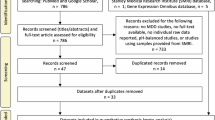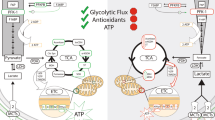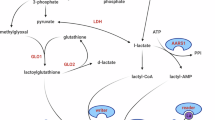Abstract
Converging evidence from molecular to neuroimaging studies suggests brain energy metabolism abnormalities in both schizophrenia and bipolar disorder. One emerging hypothesis is: decreased oxidative phosphorylation leading to accumulation of lactic acid from glycolysis and subsequent acidification of tissue. In this regard, integrating lactate and pH data from magnetic resonance spectroscopy (MRS) studies in both diseases may help us understand underlying neurobiological mechanisms. In order to achieve this goal, we performed a systematic search of case–control studies examining brain lactate or pH among schizophrenia and/or bipolar patients by using MRS. Medline/Pubmed and EBSCO databases were searched separately for both diseases and outcomes. Our search yielded 33 studies in total composed of 7 lactate and 26 pH studies. In bipolar disorder, 5 out of 6 studies have found elevated lactate levels especially in the cingulate cortex and 4 out of 13 studies reported reduced pH in the frontal lobe. In contrast, in schizophrenia a single study has examined lactate and reported elevation, while only 2 out of 13 studies examining pH have reported reduction in this measure. There were no consistent patterns for the relationship between lactate or pH levels and medication use, disease type, mood state, and other clinical variables. We highlight the need for future studies combining 1H-MRS and 31P-MRS approaches, using longitudinal designs to examine lactate and pH in disease progression across both schizophrenia and bipolar disorders.
Similar content being viewed by others
Log in or create a free account to read this content
Gain free access to this article, as well as selected content from this journal and more on nature.com
or
References
WHO. WHO Media Centre, Fact Sheets, Mental Health. 2017. http://www.who.int/mediacentre/factsheets/fs396/en/ (accessed on 22 June 2017)
Swartz MS, Perkins DO, Stroup TS, Davis SM, Capuano G, Rosenheck RA, Investigators C. Effects of antipsychotic medications on psychosocial functioning in patients with chronic schizophrenia: findings from the NIMH CATIE study. Am J Psychiatry. 2007;164:428–36. https://doi.org/10.1176/ajp.2007.164.3.428.
Tohen M, Hennen J, Zarate CM Jr., Baldessarini RJ, Strakowski SM, Stoll AL, Cohen BM. Two-year syndromal and functional recovery in 219 cases of first-episode major affective disorder with psychotic features. Am J Psychiatry. 2000;157:220–8. https://doi.org/10.1176/appi.ajp.157.2.220
Clay HB, Sillivan S, Konradi C. Mitochondrial dysfunction and pathology in bipolar disorder and schizophrenia. Int J Dev Neurosci. 2011;29:311–24. https://doi.org/10.1016/j.ijdevneu.2010.08.007
Dienel GA. Brain lactate metabolism: the discoveries and the controversies. J Cereb Blood Flow Metab. 2012;32:1107–38. https://doi.org/10.1038/jcbfm.2011.175
Schurr A, West CA, Rigor BM. Lactate-supported synaptic function in the rat hippocampal slice preparation. Science. 1988;240:1326–8.
Baltan S. Can lactate serve as an energy substrate for axons in good times and in bad, in sickness and in health? Metab Brain Dis. 2015;30:25–30. https://doi.org/10.1007/s11011-014-9595-3
Ruffin VA, Salameh AI, Boron WF, Parker MD. Intracellular pH regulation by acid-base transporters in mammalian neurons. Front Physiol. 2014;5:43 https://doi.org/10.3389/fphys.2014.00043
Hagihara H, Catts VS, Katayama Y, Shoji H, Takagi T, Huang FL, Miyakawa T. Decreased brain pH as a shared endophenotype of psychiatric disorders. Neuropsychopharmacology . 2017;43:459–68. https://doi.org/10.1038/npp.2017.167
Kato T. Mitochondrial dysfunction in bipolar disorder: from 31P-magnetic resonance spectroscopic findings to their molecular mechanisms. Int Rev Neurobiol. 2005;63:21–40. https://doi.org/10.1016/S0074-7742(05)63002-4
Novak J, Wilson M, Macpherson L, Arvanitis TN, Davies NP, Peet AC. Clinical protocols for (3)(1)P MRS of the brain and their use in evaluating optic pathway gliomas in children. Eur J Radiol. 2014;83:e106–12. https://doi.org/10.1016/j.ejrad.2013.11.009
Yildiz A, Sachs GS, Dorer DJ, Renshaw PF. 31P Nuclear magnetic resonance spectroscopy findings in bipolar illness: a meta-analysis. Psychiatry Res. 2001;106:181–91.
Rowland LM, Pradhan S, Korenic S, Wijtenburg SA, Hong LE, Edden RA, Barker PB. Elevated brain lactate in schizophrenia: a 7 T magnetic resonance spectroscopy study. Transl Psychiatry. 2016;6:e967 https://doi.org/10.1038/tp.2016.239
Friedman SD, Dager SR, Parow A, Hirashima F, Demopulos C, Stoll AL, Renshaw PF. Lithium and valproic acid treatment effects on brain chemistry in bipolar disorder. Biol Psychiatry. 2004;56:340–8. https://doi.org/10.1016/j.biopsych.2004.06.012
Dager SR, Friedman SD, Parow A, Demopulos C, Stoll AL, Lyoo IK, Renshaw PF. Brain metabolic alterations in medication-free patients with bipolar disorder. Arch Gen Psychiatry. 2004;61:450–8. https://doi.org/10.1001/archpsyc.61.5.450
Brady RO Jr., Cooper A, Jensen JE, Tandon N, Cohen B, Renshaw P, Ongur D. A longitudinal pilot proton MRS investigation of the manic and euthymic states of bipolar disorder. Transl Psychiatry. 2012;2:e160. https://doi.org/10.1038/tp.2012.84
Soeiro-de-Souza MG, Pastorello BF, Leite Cda C, Henning A, Moreno, RA, Garcia Otaduy MC. Dorsal Anterior Cingulate Lactate and Glutathione Levels in Euthymic Bipolar I Disorder: 1H-MRS study. Int J Neuropsychopharmacol. 2016;19. https://doi.org/10.1093/ijnp/pyw032
Machado-Vieira R, Zanetti MV, Otaduy MC, De Sousa RT, Soeiro-de-Souza MG, Costa AC, Gattaz WF. Increased brain lactate during depressive episodes and reversal effects by lithium monotherapy in drug-naive bipolar disorder: a 3-T 1H-MRS study. J Clin Psychopharmacol. 2017;37:40–5. https://doi.org/10.1097/JCP.0000000000000616
Xu J, Dydak U, Harezlak J, Nixon J, Dzemidzic M, Gunn AD, Anand A. Neurochemical abnormalities in unmedicated bipolar depression and mania: a 2D 1H MRS investigation. Psychiatry Res. 2013;213:235–41. https://doi.org/10.1016/j.pscychresns.2013.02.008
Chu WJ, Delbello MP, Jarvis KB, Norris MM, Kim MJ, Weber W, Adler CM. Magnetic resonance spectroscopy imaging of lactate in patients with bipolar disorder. Psychiatry Res. 2013;213:230–4. https://doi.org/10.1016/j.pscychresns.2013.03.004
Shioiri T, Kato T, Inubushi T, Murashita J, Takahashi S. Correlations of phosphomonoesters measured by phosphorus-31 magnetic resonance spectroscopy in the frontal lobes and negative symptoms in schizophrenia. Psychiatry Res. 1994;55:223–35. https://doi.org/10.1016/0165-1781(95)91247-B
Kato T, Shioiri T, Murashita J, Hamakawa H, Inubushi T, Takahashi S. Lateralized abnormality of high-energy phosphate and bilateral reduction of phosphomonoester measured by phosphorus-31 magnetic resonance spectroscopy of the frontal lobes in schizophrenia. Psychiatry Res. 1995;61:151–60.
Du F, Cooper AJ, Thida T, Sehovic S, Lukas SE, Cohen BM, Ongur D. In vivo evidence for cerebral bioenergetic abnormalities in schizophrenia measured using 31P magnetization transfer spectroscopy. JAMA Psychiatry. 2014;71:19–27. https://doi.org/10.1001/jamapsychiatry.2013.2287
Riehemann S, Hubner G, Smesny S, Volz HP, Sauer H. Do neuroleptics alter the cerebral intracellular pH value in schizophrenics?-a (31)P-MRS study on three different patient groups. Psychiatry Res. 2002;114:113–7.
Kato T, Takahashi S, Shioiri T, Inubushi T. Brain phosphorous metabolism in depressive disorders detected by phosphorus-31 magnetic resonance spectroscopy. J Affect Disord. 1992;26:223–30.
Kato T, Takahashi S, Shioiri T, Inubushi T. Alterations in brain phosphorous metabolism in bipolar disorder detected by in vivo 31P and 7Li magnetic resonance spectroscopy. J Affect Disord. 1993;27:53–9.
Kato T, Shioiri T, Murashita J, Hamakawa H, Inubushi T, Takahashi S. Phosphorus-31 magnetic resonance spectroscopy and ventricular enlargement in bipolar disorder. Psychiatry Res. 1994;55:41–50.
Hamakawa H, Murashita J, Yamada N, Inubushi T, Kato N, Kato T. Reduced intracellular pH in the basal ganglia and whole brain measured by 31P-MRS in bipolar disorder. Psychiatry Clin Neurosci. 2004;58:82–8.
Kato T, Murashita J, Kamiya A, Shioiri T, Kato N, Inubushi T. Decreased brain intracellular pH measured by 31P-MRS in bipolar disorder: a confirmation in drug-free patients and correlation with white matter hyperintensity. Eur Arch Psychiatry Clin Neurosci. 1998;248:301–6.
Kato T, Takahashi S, Shioiri T, Murashita J, Hamakawa H, Inubushi T. Reduction of brain phosphocreatine in bipolar II disorder detected by phosphorus-31 magnetic resonance spectroscopy. J Affect Disord. 1994;31:125–33.
Murashita J, Kato T, Shioiri T, Inubushi T, Kato N. Altered brain energy metabolism in lithium-resistant bipolar disorder detected by photic stimulated 31P-MR spectroscopy. Psychol Med. 2000;30:107–15.
Deicken RF, Fein G, Weiner MW. Abnormal frontal lobe phosphorous metabolism in bipolar disorder. Am J Psychiatry. 1995;152:915–8. https://doi.org/10.1176/ajp.152.6.915
Deicken RF, Weiner MW, Fein G. Decreased temporal lobe phosphomonoesters in bipolar disorder. J Affect Disord. 1995;33:195–9.
Du F, Yuksel C, Chouinard VA, Huynh P, Ryan K, Cohen BM, Ongur D. Abnormalities in high-energy phosphate metabolism in first-episode bipolar disorder measured using 31P-magnetic resonance spectroscopy. Biol Psychiatry. 2017. https://doi.org/10.1016/j.biopsych.2017.03.025
Jensen JE, Daniels M, Haws C, Bolo NR, Lyoo IK, Yoon SJ, Renshaw PF. Triacetyluridine (TAU) decreases depressive symptoms and increases brain pH in bipolar patients. Exp Clin Psychopharmacol. 2008;16:199–206. https://doi.org/10.1037/1064-1297.16.3.199
Shi XF, Carlson PJ, Sung YH, Fiedler KK, Forrest LN, Hellem TL, Kondo DG. Decreased brain PME/PDE ratio in bipolar disorder: a preliminary (31) P magnetic resonance spectroscopy study. Bipolar Disord. 2015;17:743–52. https://doi.org/10.1111/bdi.12339
Kim DJ, Lyoo IK, Yoon SJ, Choi T, Lee B, Kim JE, Renshaw PF. Clinical response of quetiapine in rapid cycling manic bipolar patients and lactate level changes in proton magnetic resonance spectroscopy. Prog Neuropsychopharmacol Biol Psychiatry. 2007;31:1182–8. https://doi.org/10.1016/j.pnpbp.2007.04.009
Layton ME, Friedman SD, Dager SR. Brain metabolic changes during lactate-induced panic: effects of gabapentin treatment. Depress Anxiety. 2001;14:251–4.
Dager SR, Richards T, Strauss W, Artru A. Single-voxel 1H-MRS investigation of brain metabolic changes during lactate-induced panic. Psychiatry Res. 1997;76:89–99.
Dager SR, Strauss WL, Marro KI, Richards TL, Metzger GD, Artru AA. Proton magnetic resonance spectroscopy investigation of hyperventilation in subjects with panic disorder and comparison subjects. Am J Psychiatry. 1995;152:666–72. https://doi.org/10.1176/ajp.152.5.666
Maddock RJ, Buonocore MH, Miller AR, Yoon JH, Soosman SK, Unruh AM. Abnormal activity-dependent brain lactate and glutamate+glutamine responses in panic disorder. Biol Psychiatry. 2013;73:1111–9. https://doi.org/10.1016/j.biopsych.2012.12.015
Ryan MC, Collins P, Thakore JH. Impaired fasting glucose tolerance in first-episode, drug-naive patients with schizophrenia. Am J Psychiatry. 2003;160:284–9. https://doi.org/10.1176/appi.ajp.160.2.284
Venkatasubramanian G, Chittiprol S, Neelakantachar N, Naveen MN, Thirthall J, Gangadhar BN, Shetty KT. Insulin and insulin-like growth factor-1 abnormalities in antipsychotic-naive schizophrenia. Am J Psychiatry. 2007;164:1557–60. https://doi.org/10.1176/appi.ajp.2007.07020233
Verma SK, Subramaniam M, Liew A, Poon LY. Metabolic risk factors in drug-naive patients with first-episode psychosis. J Clin Psychiatry. 2009;70:997–1000. https://doi.org/10.4088/JCP.08m04508
Magnotta VA, Heo HY, Dlouhy BJ, Dahdaleh NS, Follmer RL, Thedens DR, Wemmie JA. Detecting activity-evoked pH changes in human brain. Proc Natl Acad Sci USA. 2012;109:8270–3. https://doi.org/10.1073/pnas.1205902109
Shirayama Y, Yano T, Takahashi K, Takahashi S, Ogino T. In vivo31P NMR spectroscopy shows an increase in glycerophosphorylcholine concentration without alterations in mitochondrial function in the prefrontal cortex of medicated schizophrenic patients at rest. European journal of neuroscience. 2004;20:749–756.
Volz HP, Rzanny R, Rössger G, Hübner G, Kreitschmann-Andermahr I, Kaiser WA, Sauer H. 31Phosphorus magnetic resonance spectroscopy of the dorsolateral prefrontal region in schizophrenics—a study including 50 patients and 36 controls. Biological Psychiatry. 1998;44:399–404.
Volz HP, Rzanny R, Röβger G, Hübner G, Kreitschmann-Andermahr I, Kaiser WA, Sauer H. Decreased energy demanding processes in the frontal lobes of schizophrenics due to neuroleptics? A 31P-magneto-resonance spectroscopic study. Psychiatry Research: Neuroimaging. 1997a;76:123–129.
Volz HP, Rzanny R, May S, Hegewald H, Preuiβler B, Hajek M, Kaiser WA, Sauer H. 31P magnetic resonance spectroscopy in the dorsolateral prefrontal cortex of schizophrenics with a volume selective technique—preliminary findings. Biological psychiatry. 1997b;41:644–648.
Deicken RF, Calabrese G, Merrin EL, Meyerhoff DJ, Dillon WP, Weiner MW, Fein G. 31Phosphorus magnetic resonance spectroscopy of the frontal and parietal lobes in chronic schizophrenia. Biological psychiatry. 1994;36:503–510.
Calabrese G, Deicken RF, Fein G, Merrin EL, Schoenfeld F, Wiener MW. 31Phosphorus magnetic resonance spectroscopy of the temporal lobes in schizophrenia. Biological Psychiatry. 1992;32:26–32.
Fujimoto T, Nakano T, Takano T, Hokazono Y, Asakura T, Tsuji T. Study of chronic schizophrenics using 31P magnetic resonance chemical shift imaging. Acta Psychiatrica Scandinavica. 1992;86:455–462.
O'Callaghan E, Redmond O, Ennis R, Stack J, Kinsella A, Ennis JT, Waddington JL. Initial investigation of the left temporoparietal region in schizophrenia by 31P magnetic resonance spectroscopy. Biological psychiatry. 1991;29:1149–1152.
Pettegrew JW, Keshavan MS, Panchalingam K, Strychor S, Kaplan DB, Tretta MG, Allen M. Alterations in brain high-energy phosphate and membrane phospholipid metabolism in firstepisode, drug-naive schizophrenics: A pilot study of the dorsal prefrontal cortex by in vivo phosphorus 31 nuclear magnetic resonance spectroscopy. Archives of general psychiatry. 1991;48:563–568.
Williamson P, Drost D, Stanley J, Carr T, Morrison S, Merskey H. Localized phosphorus 31 magnetic resonance spectroscopy in chronic schizophrenic patients and normal controls. Archives of general psychiatry. 1991;48:578–578.
Chouinard VA, Kim SY, Valeri L, Yuksel C, Ryan KP, Chouinard G, Cohen Bruce M, Du F, Öngür D. Brain bioenergetics and redox state measured by 31P magnetic resonance spectroscopy in unaffected siblings of patients with psychotic disorders. Schizophrenia research. 2017;187:11–16.
Yuksel C, Du F, Ravichandran C, Goldbach JR, Thida T, Lin P, Dora B, Gelda J, O'Connor L, Sehovic S, Gruber S. Abnormal high-energy phosphate molecule metabolism during regional brain activation in patients with bipolar disorder. Molecular psychiatry. 2015;20:1079.
Acknowledgements
We thank to Dr. Zafer Dogan for his contribution to the manuscript. This review was funded by MH104449(DO) to Dost Ongur, R21MH114020 to Fei Du, NIMH 5T32MH016259(MS) to Virginie-Anne Chouinard and Maria Lorenz Pope Fellowship Award to Cagri Yuksel. No funding body had any involvement in the interpretation of the data, writing of the manuscript or decision to publish.
Author information
Authors and Affiliations
Corresponding author
Ethics declarations
Competing interests
DÖ served on a Scientific Advisory Board for Neurocrine Inc. in 2017. The reamining authors declare no competing interests.
Additional information
Publisher's note: Springer Nature remains neutral with regard to jurisdictional claims in published maps and institutional affiliations.
Rights and permissions
About this article
Cite this article
Dogan, A.E., Yuksel, C., Du, F. et al. Brain lactate and pH in schizophrenia and bipolar disorder: a systematic review of findings from magnetic resonance studies. Neuropsychopharmacol 43, 1681–1690 (2018). https://doi.org/10.1038/s41386-018-0041-9
Received:
Revised:
Accepted:
Published:
Issue date:
DOI: https://doi.org/10.1038/s41386-018-0041-9
This article is cited by
-
A rare case of isovaleric acidemia and schizophrenia: a case report
BMC Psychiatry (2025)
-
Blood and neuronal extracellular vesicle mitochondrial disruptions in schizophrenia
Neuropsychopharmacology (2025)
-
The role of protein lactylation in brain health and disease: current advances and future directions
Cell Death Discovery (2025)
-
Functional associations of the gut microbiome with dopamine, serotonin, and BDNF in schizophrenia: a pilot study
The Egyptian Journal of Neurology, Psychiatry and Neurosurgery (2024)
-
Focusing on mitochondria in the brain: from biology to therapeutics
Translational Neurodegeneration (2024)



